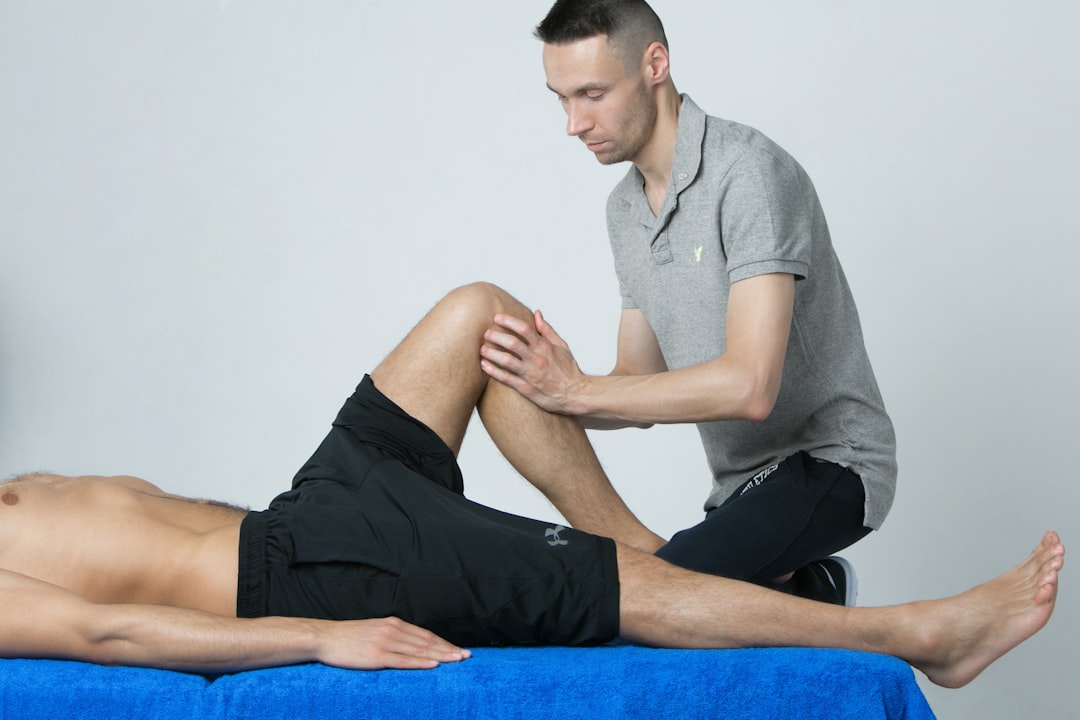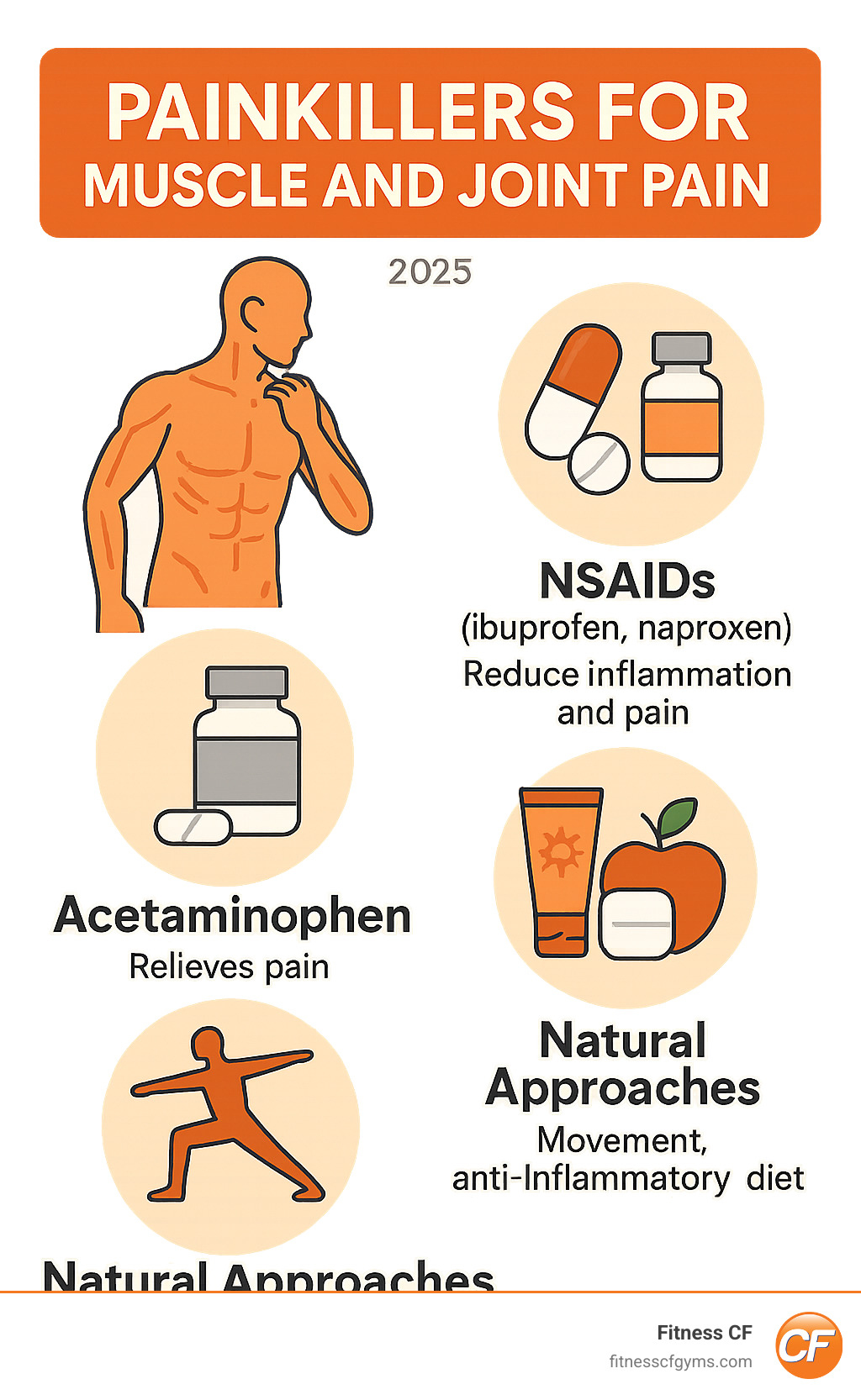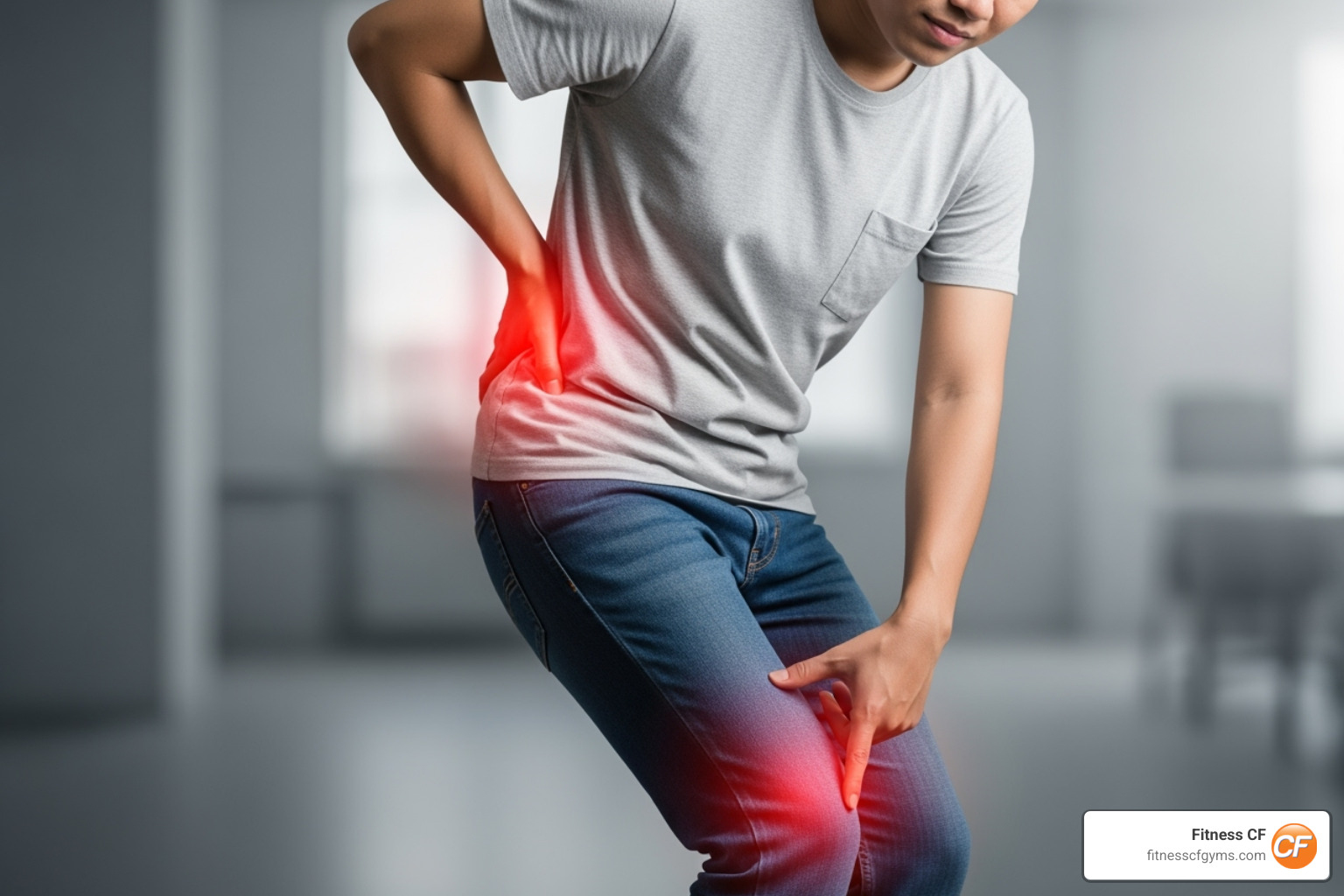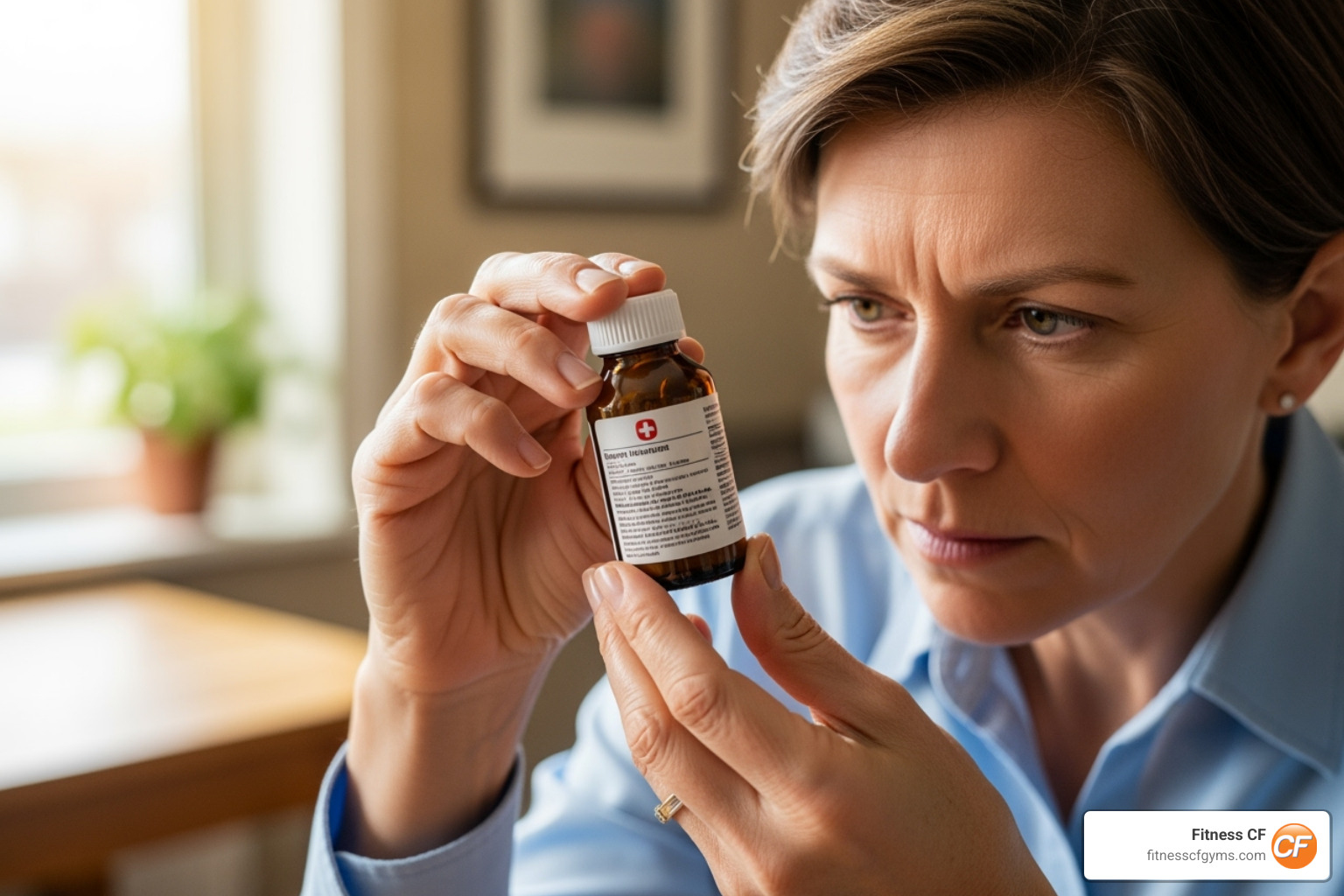Ease the Ache: Your Guide to Painkillers for Muscle and Joint Discomfort

Why Painkillers Matter for Active Living
Painkillers for muscle and joint pain are essential tools for maintaining an active, healthy lifestyle when discomfort strikes. Whether you’re dealing with post-workout soreness, chronic joint stiffness, or acute injury pain, understanding your relief options helps you get back to the activities you love faster.
Common painkillers for muscle and joint pain include:
- NSAIDs (ibuprofen, naproxen) – reduce inflammation and pain
- Acetaminophen – relieves pain without anti-inflammatory effects
- Topical treatments – gels, creams, and patches for targeted relief
- Natural approaches – heat/cold therapy, gentle movement, anti-inflammatory foods
Almost 60 million people have arthritis, and muscle pain affects countless more from daily activities, exercise, and overuse. The good news? You have multiple effective options for relief that can keep you moving toward your fitness goals.
Pain doesn’t have to sideline your healthy lifestyle. When you understand how different painkillers work – from blocking inflammation with NSAIDs to providing targeted relief with topical treatments – you can make informed choices that support both immediate comfort and long-term wellness.
The key is finding the right combination of pain relief and healthy movement patterns that work for your body.
As Pleasant Lewis, owner of Fitness CF with over 40 years in the fitness industry, I’ve helped thousands of members steer the use of painkillers for muscle and joint pain while maintaining their active lifestyles. Through decades of working with people from all fitness levels, I’ve learned that effective pain management combines smart medication choices with consistent, appropriate movement.

Why Do My Muscles and Joints Hurt?
Understanding why your muscles and joints hurt is the first step toward finding the right painkillers for muscle and joint pain and getting back to your active lifestyle. Pain can strike anyone – from weekend warriors to daily gym-goers to those simply dealing with everyday activities.
Muscle pain, also called myalgia, happens for many reasons. The most common culprit? Overexertion from pushing too hard during workouts or trying new activities. That familiar soreness you feel 24-48 hours after exercise is called Delayed Onset Muscle Soreness (DOMS) – it’s actually tiny tears in your muscle fibers healing and getting stronger.
But muscle pain isn’t just about exercise. Poor posture from sitting at desks all day creates tension in your neck, shoulders, and back. Sprains and strains from lifting incorrectly or sudden movements can leave you sore for days. Sometimes muscle pain signals broader issues like fibromyalgia, which causes widespread pain along with fatigue and sleep problems.
Joint pain (arthralgia) is a different beast entirely. Your joints are complex structures that bear weight and allow movement – when they hurt, everything becomes harder. Injury is one obvious cause, whether it’s a twisted ankle or a shoulder strain from overhead movements.
Chronic conditions like arthritis affect millions of people. Osteoarthritis develops when cartilage wears down over time, leading to that grinding, aching feeling especially in knees, hips, and hands. Rheumatoid arthritis is an autoimmune condition where your body attacks its own joint tissues, causing swelling and pain.
Inflammation is often the common thread connecting muscle and joint pain. Whether from injury, overuse, or chronic conditions, inflammation creates that hot, swollen, painful feeling that makes movement difficult.
The location and type of your pain offers important clues. Sharp, sudden pain often means injury, while dull, aching pain might indicate overuse or chronic conditions. Pain that worsens with activity could mean inflammation, while stiffness that improves with gentle movement often responds well to heat therapy and light exercise.
Understanding your specific pain pattern helps you choose the most effective relief strategy – whether that’s the right medication, movement therapy, or a combination approach.

A Guide to Over-the-Counter (OTC) Painkillers for Muscle and Joint Pain
When muscle soreness hits after a great workout or joint stiffness makes your morning routine challenging, over-the-counter pain relievers become your trusted allies. These accessible medications are often the first step toward getting back to your active lifestyle, whether you’re dealing with post-exercise discomfort or everyday aches.
Painkillers for muscle and joint pain come in several forms, each working differently in your body. Understanding these differences helps you make smarter choices about what might work best for your specific situation. The key is knowing which type targets your particular pain pattern most effectively.
NSAIDs: Fighting Inflammation and Pain
Nonsteroidal Anti-Inflammatory Drugs are powerhouse medications that tackle both pain and swelling. Ibuprofen (found in Advil and Motrin) and naproxen (Aleve) are the most common options you’ll find at any pharmacy.
These medications work by blocking special enzymes called COX enzymes in your body. Think of these enzymes as switches that turn on inflammation. When you block them, you reduce the production of prostaglandins – the chemical messengers that create pain, swelling, and heat in injured tissues.
This dual action makes NSAIDs particularly valuable for sports injuries, muscle strains, and conditions like arthritis where inflammation plays a major role. If you’ve ever noticed how ibuprofen helps both the pain and swelling after tweaking your back during strength training, you’ve experienced this mechanism firsthand.
Naproxen offers longer-lasting relief than ibuprofen, often requiring only twice-daily dosing. This makes it convenient for managing ongoing discomfort that might interfere with your regular fitness routine.
However, NSAIDs do carry some risks. Stomach irritation is the most common concern, especially with regular use. More serious issues can include kidney problems and increased blood pressure. The good news is that using the lowest effective dose for the shortest time needed minimizes these risks significantly.
For detailed information about how these medications work, check out What are NSAIDs?.
Acetaminophen: A Different Approach to Pain Relief
Acetaminophen takes a completely different approach to pain relief. Unlike NSAIDs, it’s not anti-inflammatory – instead, it works primarily in your central nervous system to block pain signals before they fully register in your brain.
This unique mechanism of action makes acetaminophen particularly effective for non-inflammatory pain like general muscle aches, headaches, or the overall body soreness you might feel during recovery from intense cardio sessions.
The biggest advantage of acetaminophen is its gentleness on your stomach. If NSAIDs cause digestive upset or you have stomach sensitivities, acetaminophen often provides a comfortable alternative for managing pain.
The main concern with acetaminophen is potential liver damage if you exceed recommended dosage limits. Never take more than 4,000 mg in a 24-hour period, and be especially careful about alcohol interaction – combining the two significantly increases liver risk.
Topical Treatments: Targeted Relief Right Where You Need It
Sometimes the best approach is going straight to the source. Topical treatments – including gels, creams, and patches – deliver relief exactly where you need it without circulating throughout your entire system.
This localized relief approach means fewer systemic side effects compared to oral medications. You get the benefits of pain relief while minimizing concerns about stomach upset or other internal effects.
Diclofenac gels work like topical NSAIDs, reducing inflammation right at the site of pain. They’re particularly effective for joint pain in areas like knees, hands, and elbows – spots that often feel stiff after strength training sessions.
Menthol-based products create a cooling sensation that interrupts pain signals while increasing blood flow to the area. Capsaicin creams work differently, initially causing warmth before reducing pain sensitivity over time.
Salicylates in topical form provide aspirin-like benefits directly through the skin, offering both pain relief and mild anti-inflammatory effects.
The beauty of topical treatments lies in their precision. You can address specific problem areas while maintaining your active lifestyle without worrying about the internal effects that sometimes come with oral medications. For more insights into this approach, explore Targeted pain management research.
The Foundation of Relief: Movement and Lifestyle Strategies
While painkillers for muscle and joint pain provide essential immediate relief, the real secret to long-term comfort lies in building a lifestyle that supports your body’s natural healing abilities. Think of pain medication as the emergency response team – they’re there when you need them most. But movement and healthy living? That’s your daily maintenance crew, keeping everything running smoothly.
The beauty of this approach is that it doesn’t just mask pain – it actually addresses many of the root causes. When you strengthen your muscles, improve your flexibility, and support your body with good nutrition, you’re creating a foundation that makes pain less likely to occur in the first place.
Immediate Care: The R.I.C.E. Method and Heat Therapy
When you first injure yourself – whether it’s a twisted ankle or a pulled muscle – how you respond in those first few hours can make a huge difference in your recovery. The R.I.C.E. method has been helping people bounce back faster for decades, and it’s as relevant today as ever.
Rest doesn’t mean becoming a couch potato, but it does mean giving your injured area a break from whatever caused the problem. If you tweaked your back lifting boxes, maybe skip the heavy lifting for a few days. Ice is your friend for the first 24-48 hours – those 15-20 minute sessions help calm down the inflammation and numb the pain. Compression with an elastic bandage gives your injury some gentle support while reducing swelling. Just make sure it’s snug, not tight enough to cut off circulation. Elevation helps gravity work in your favor, draining excess fluid away from the injured area.
Once that initial inflammation settles down, it’s time to switch gears to heat therapy. A warm bath with Epsom salts or a hot shower can work wonders for chronic stiffness. Heat increases blood flow to sore muscles, bringing in healing nutrients and washing away waste products. It’s like giving your muscles a gentle, warming hug from the inside out.
The Power of Proactive Fitness for Pain Management
Here’s where things get really exciting – regular exercise isn’t just good for your overall health, it’s one of the most powerful pain prevention tools you have. When you strengthen the muscles around your joints, you’re essentially building a natural support system for your body.
Think about your core muscles supporting your lower back, or strong leg muscles taking pressure off your knees. Strength training builds this protective muscle mass while improving joint stability. Your body becomes better equipped to handle daily activities without strain or injury. Whether you’re lifting groceries or playing with your kids, stronger muscles mean less stress on your joints.
Low-impact cardio like swimming or cycling offers incredible benefits without beating up your joints. Swimming is particularly magical – the water’s buoyancy supports your body weight while you get your heart pumping. These activities also trigger the release of endorphins, your body’s natural painkillers. It’s like having a built-in pharmacy that produces feel-good chemicals every time you exercise.
Don’t underestimate the power of flexibility work either. Yoga and regular stretching keep your muscles long and supple, which means they’re less likely to pull on your joints and cause pain. When your muscles can move through their full range of motion easily, your whole body functions better. Plus, there’s something deeply satisfying about that gentle stretch that releases tension you didn’t even know you were holding.
Exploring Natural and Wellness Strategies
Your body has an amazing ability to heal itself when you give it the right support. Nutritional choices play a huge role in managing inflammation, which is often at the root of muscle and joint pain.
Omega-3 fatty acids from fatty fish like salmon and mackerel act like nature’s anti-inflammatory medicine. Regular intake can significantly reduce joint pain and stiffness, especially for inflammatory conditions. Curcumin, the golden compound in turmeric, has shown remarkable pain-relieving effects in studies – some research even suggests it can be as effective as ibuprofen for certain types of knee pain. Glucosamine supplements may help some people with cartilage health, though results can vary from person to person.
The mind-body connection in pain management is fascinating and powerful. Meditation and mindfulness practices help you develop a different relationship with discomfort. Instead of fighting pain, you learn to observe it without judgment, which often reduces its intensity. Relaxation techniques like deep breathing and progressive muscle relaxation calm your nervous system and release physical tension.
Natural anti-inflammatory foods can become delicious allies in your pain management journey. Fatty fish, leafy greens like spinach and kale, colorful berries, nuts, olive oil, turmeric, ginger, and green tea all contain compounds that help your body fight inflammation naturally. The best part? These foods taste great and support your overall health too.
When you combine smart use of painkillers for muscle and joint pain with these natural strategies, you’re creating a comprehensive approach that addresses both immediate relief and long-term wellness. It’s not about choosing one or the other – it’s about using all the tools available to keep you moving comfortably through life.
Using Pain Relievers Safely and Effectively
The key to successful pain management lies in making informed choices about painkillers for muscle and joint pain. It’s all about finding that sweet spot – getting the relief you need while minimizing any potential risks. Think of it as fine-tuning your approach to match your body’s specific needs.
When you’re dealing with muscle soreness from a great workout or joint stiffness from daily activities, responsible medication use means starting with the lowest effective dose and using it for the shortest duration necessary. This approach helps you stay active and comfortable while protecting your overall health.
Your local pharmacist is an incredible resource – they’re medication experts who can answer questions about drug interactions, proper dosing, and which option might work best for your specific situation. Don’t hesitate to have a quick chat with them when you’re unsure.

Comparing common painkillers for muscle and joint pain
Understanding how different painkillers for muscle and joint pain stack up against each other helps you make the right choice for your situation. Here’s a straightforward comparison of your main OTC options:
| Feature | Acetaminophen (e.g., Tylenol) | Ibuprofen (e.g., Advil, Motrin) | Naproxen (e.g., Aleve) |
|---|---|---|---|
| Primary Action | Pain reliever, fever reducer | Pain reliever, anti-inflammatory, fever reducer | Pain reliever, anti-inflammatory, fever reducer |
| Effectiveness for Inflammation | Low/None | High | High |
| Speed of Relief | Relatively fast | Fast | Slower onset than ibuprofen, but longer lasting |
| Common Side Effects | Liver damage (with overdose/alcohol) | Stomach upset, heartburn, stomach bleeding, kidney issues, fluid retention | Stomach upset, heartburn, stomach bleeding, kidney issues, fluid retention |
| Dosing Frequency | Every 4-6 or 8 hours (depending on formulation) | Every 4-6 hours | Every 8-12 hours |
| Best For | General pain, fever, non-inflammatory arthritis | Muscle pain, joint pain, sports injuries, inflammatory pain | Muscle strains, joint pain, inflammatory pain requiring longer duration of action |
Note: This table provides general information. Always consult product labels and a healthcare professional for personalized advice.
If you’re dealing with post-workout muscle soreness or inflammation from overuse, ibuprofen or naproxen are typically your best bets since they tackle both pain and swelling. For general aches without significant inflammation, acetaminophen might be gentler on your stomach while still providing solid relief.
Important Safety Considerations for painkillers for muscle and joint pain
Safety isn’t just about following directions on the bottle – though that’s definitely important! It’s about understanding how these medications interact with your lifestyle, other medications, and your body’s unique needs.
Alcohol and medication interactions are serious business. Mixing NSAIDs with alcohol significantly increases your risk of stomach bleeding and liver problems. Acetaminophen and alcohol together can cause severe liver damage, even at doses that would normally be safe. If you enjoy an evening drink or weekend socializing, plan your pain relief accordingly and avoid this dangerous combination.
When it comes to other medications, NSAIDs can interfere with blood thinners, certain antidepressants, and heart or blood pressure medications. Acetaminophen also interacts with blood thinners. Always give your doctor or pharmacist a complete list of everything you’re taking, including supplements and over-the-counter products.
Age brings additional considerations. If you’re 60 or older, your body processes medications differently, and you’re at higher risk for stomach bleeding and kidney problems from NSAIDs. This doesn’t mean you can’t use them, but it does mean being extra cautious and possibly choosing lower doses or shorter treatment periods.
Pregnancy requires special attention to medication choices. Ibuprofen should be avoided after 20 weeks of pregnancy as it may harm the developing baby or complicate delivery. Acetaminophen is generally considered safer during pregnancy, but any medication use should be discussed with your healthcare provider first.
Long-term use of any painkiller comes with risks that are worth understanding. Regular NSAID use can lead to stomach ulcers, kidney damage, and increased heart attack or stroke risk. Even “safer” acetaminophen can damage your kidneys with chronic use and will cause liver failure if you exceed recommended doses.
The golden rule is simple: listen to your body and never exceed recommended dosages. If your pain persists despite using painkillers for muscle and joint pain, or if you experience any concerning side effects, it’s time to seek medical attention. Persistent pain often signals an underlying issue that needs professional evaluation, and your healthcare provider can help you find the safest, most effective treatment plan to keep you active and comfortable.
Conclusion: A Balanced Path to Lasting Comfort
Managing painkillers for muscle and joint pain doesn’t have to feel overwhelming. With the right knowledge and approach, you can make smart choices that support your active, healthy lifestyle. We’ve covered everything from NSAIDs like ibuprofen and naproxen that fight inflammation, to acetaminophen for general pain relief, and topical treatments that target discomfort right where you need it most.
But here’s the thing – medication is really just one tool in your wellness toolkit. The real magic happens when you combine smart pain relief choices with a lifestyle built around healthy living and consistent movement. Think of painkillers as your short-term allies while you build long-term strength and resilience.
The benefits of strength training go far beyond looking good. When you strengthen the muscles around your joints, you’re creating natural shock absorbers that protect against future pain. Strong glutes support your lower back, powerful leg muscles stabilize your knees, and a solid core keeps everything aligned and working smoothly.
Cardio benefits extend into pain management too. Regular cardiovascular exercise boosts those wonderful endorphins – your body’s own natural painkillers. Whether it’s a brisk walk, swimming, or cycling, getting your heart pumping helps reduce pain sensitivity while improving your overall fitness and mood.
The beauty of an integrated approach is that each element supports the others. You might use an NSAID to manage acute pain from a workout, apply ice using the R.I.C.E. method for immediate relief, then focus on gentle stretching and strengthening exercises as you heal. Meanwhile, eating anti-inflammatory foods and practicing stress-reducing techniques create an environment where your body can heal and thrive.
Movement truly is medicine. Regular physical activity keeps your joints lubricated, your muscles flexible, and your bones strong. It’s not about pushing through pain, but about finding the right balance of activity that supports healing and prevents future problems.
Achieving a pain-free, active life is absolutely within your reach. By making informed decisions about painkillers for muscle and joint pain and weaving them into a broader strategy of healthy living, you can keep doing the activities that bring you joy and vitality. If you’re looking for additional recovery options to complement your pain management strategy, consider exploring therapeutic amenities like hydromassage to help soothe those hard-working muscles.
Your journey to lasting comfort starts with small, consistent choices. Choose movement over sedentary habits, choose whole foods over processed ones, and choose the right pain relief tools when you need them. Your future self will thank you for building this foundation of wellness today.






